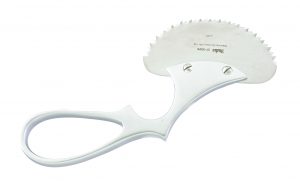The plaster room is a specialized area within an orthopedic clinic or in the Emergency Department where patients receive casts or splints for the treatment of bone and joint injuries. The plaster room is equipped with all the necessary materials and equipment to create custom casts and splints, and it is staffed by trained professionals such as orthopedic technologists or cast technicians.
Some of the common instruments found in a plaster room include:
Plaster saw
A plaster saw is a handheld electric or pneumatic saw that is used to remove a cast or splint from a patient’s body. The saw is designed to cut through the plaster or fiberglass material without damaging the patient’s skin or underlying tissues.
Scissors
Scissors are an essential tool in the plaster room and are used to cut and shape the padding and casting material. The scissors used in the plaster room are typically larger and heavier than standard scissors to make it easier to cut through the thick padding and casting material.
Casting material
The plaster room contains various types of casting materials, such as plaster, fiberglass, and thermoplastics. These materials are used to create casts and splints that are customized to the patient’s specific injury and body shape.
Padding
Padding is used to provide cushioning and protection between the patient’s skin and the casting material. It is also used to create pressure points to help support the healing process.
Measuring tools
Measuring tools such as rulers, tape measures, and calipers are used to ensure that the cast or splint is properly sized and shaped to fit the patient’s body.
Drying rack
A drying rack is used to hold freshly made casts and splints while they dry. This helps prevent them from becoming misshapen or damaged during the drying process.
Cleaning and sterilization tools
Instruments used in the plaster room need to be cleaned and sterilized after each use to prevent the spread of infection. The room contains a sink for cleaning and disinfecting equipment, as well as sterilization equipment such as autoclaves.
Overall, the instruments found in the plaster room play a critical role in providing patients with the customized casts and splints they need to support the healing process following an orthopedic injury. The skilled professionals in the plaster room rely on their training and expertise, as well as their specialized tools and equipment, to provide the highest quality of care to patients.
